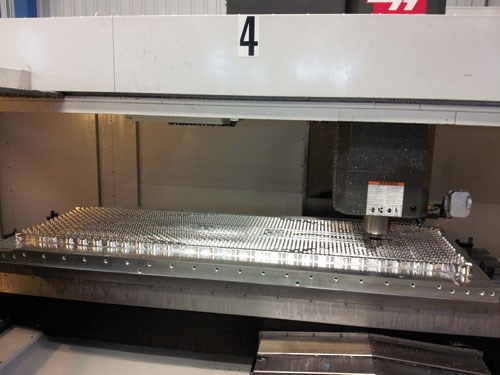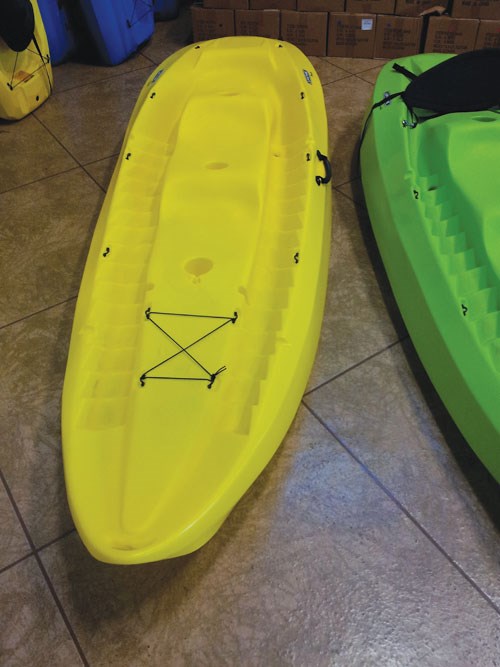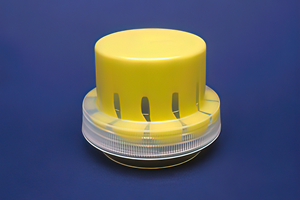Powerful CAM Brings the “Outdoors” Up to Speed
When Lifetime was looking for a sophisticated CAM product to support large files for its bigger tables and recently added kayaks, the company looked no further than PowerMILL from Delcam (Salt Lake City, UT).
While the average American may not know who Lifetime Products Inc. (Clearfield, UT) is, the chances are they own one of their products. The company manufactures a number of outdoor products from folding tables/chairs and lawn furniture to swing sets and basketball hoops to tent trailers and kayaks—all designed and manufactured largely in the United States. When Lifetime was looking for a sophisticated CAM product to support large files for its bigger tables and recently added kayaks, the company looked no further than PowerMILL from Delcam (Salt Lake City, UT).
The company uses PTC/ProE for design, but wanted a state-of-the-art CAM product to go with it, according to Mold Design Engineer/Supervisor Dennis Norman. Since Lifetime’s designs can be quite extensive, bigger molds such as the ones the company builds can have very large CAD files and this makes them difficult and time-consuming to manufacture. Lifetime had to find something that would take the large files without difficulty—a program that could complement its current processes, but extend its CAM capabilities. Lifetime wished to keep its current CAD program, but needed a CAM package that could work with it. After reviewing a number of CAD/CAM companies Lifetime decided on Delcam.
Controlling Operations
One of the ways in which Lifetime saves time and money is in its own machine shop. During the company’s early days, the engineering department discovered that when outsourcing tooling to a third party, the tooling costs increased two- to three-fold. So Lifetime started taking control of all of its operations. “With all of our design and manufacturing under our control, we are able to keep products moving quickly from design to production by eliminating bottlenecks caused by waiting for outsourced tooling to finish the mold,” Norman notes. “When things are not moving the way they should, we take action to improve them so we can give our customers a better quality product. We now have full control from part design all the way through to placing the finished goods on a truck.” PowerMILL’s role in increasing production speed has been a vital part of this process.
And quality is something that Lifetime does not sacrifice even when coming up with new design ideas for their product lines, such as its focus on reducing the amount of material in a product.
“Our tables are big and they need to be moved all the time, so we are continuously changing our molds to cut down on the weight,” Norman explains. “The lighter we can make them the better it is for our customers. For example, our current banquet table design created in CAD uses ribs, or tackoffs, on the underside. This not only cuts down on plastic, but actually makes the table stronger and not so flimsy. A great solution—but not so easy to manufacture because of their complexity. It can take hours to calculate a toolpath for these ribs.”
Norman was growing frustrated. The time to calculate toolpaths for all of its projects—from tables to kayaks to everything in between—was taking too long and holding up production. “We would wait six to eight hours for a toolpath,” he recalls. “When we ran it there was too much air cutting due to the lack of good rest machining. Overall the quality was just poor.”
Norman’s desire for more CAM functionality led him to PowerMILL. “We use PowerMILL for a majority of our large mold designs,” Norman says. “The calculation time is amazing and we get a better surface finish. It is not uncommon for software companies to say they have fast toolpath calculation, but PowerMILL backs this up with multi-threading and background processes.
It automatically performs complex calculations in the background while we can continue to work on other toolpaths. This is unique to PowerMILL.” Both foreground and background processes use fully multi-threaded functionality, so NC programs get to the machines in the shortest possible time, Norman adds.
In addition, PowerMILL has a comprehensive range of patented high-speed machining strategies that increase the speed of production. “With our previous manufacturing CAM software we were cutting way too much air,” Norman explains. “Using PowerMILL’s stock model in rest machining, we can be confident that we are constantly cutting and minimizing wasteful air moves. PowerMILL roughs out a lot more detail in tight areas that our previous programming software could not accomplish without a lot of tool retracts.”
PowerMILL’s streamlined and well-designed user interface allowed Lifetime to take on machining of the recent kayak mold quite quickly. “Once the project was done we were very impressed,” notes Norman. “We’ve never had a mold come off the machine that looked so good. It was quite the project to take on for our first time. Working with PowerMILL made it easy—the toolpaths looked impressive and the finished product was very smooth.”
For More Information:
Lifetime Products Inc. / (801) 776-1532
dnorman@lifetime.com / lifetime.com
Related Content
How to Manage Wall Thickness Changes in Your Mold Design
To ensure even filling and cooling, consider wall section transitions, corners and fillets, ribs and bosses, lip and rim designs and CAE flow simulation software.
Read MoreMold Design Review: The Complete Checklist
Gerardo (Jerry) Miranda III, former global tooling manager for Oakley sunglasses, reshares his complete mold design checklist, an essential part of the product time and cost-to-market process.
Read MoreHow to Improve Your Current Efficiency Rate
An alternative approach to taking on more EDM-intensive work when technology and personnel investment is not an option.
Read MoreHow to Select a Mold Temperature Controller
White paper shares how cooling channel analysis, which collects maximum pressure drop, total flow rate and heat dissipation, eases the performance evaluation of mold temperature controllers.
Read MoreRead Next
Feature-Based CAM Software Helps Solves Problems
For moldmakers considering jumping into aerospace work, you may be interested in the success story of one tool and die shop using feature-based CAM with Boeing Aircraft.
Read MoreReasons to Use Fiber Lasers for Mold Cleaning
Fiber lasers offer a simplicity, speed, control and portability, minimizing mold cleaning risks.
Read MoreHow to Use Strategic Planning Tools, Data to Manage the Human Side of Business
Q&A with Marion Wells, MMT EAB member and founder of Human Asset Management.
Read More

























